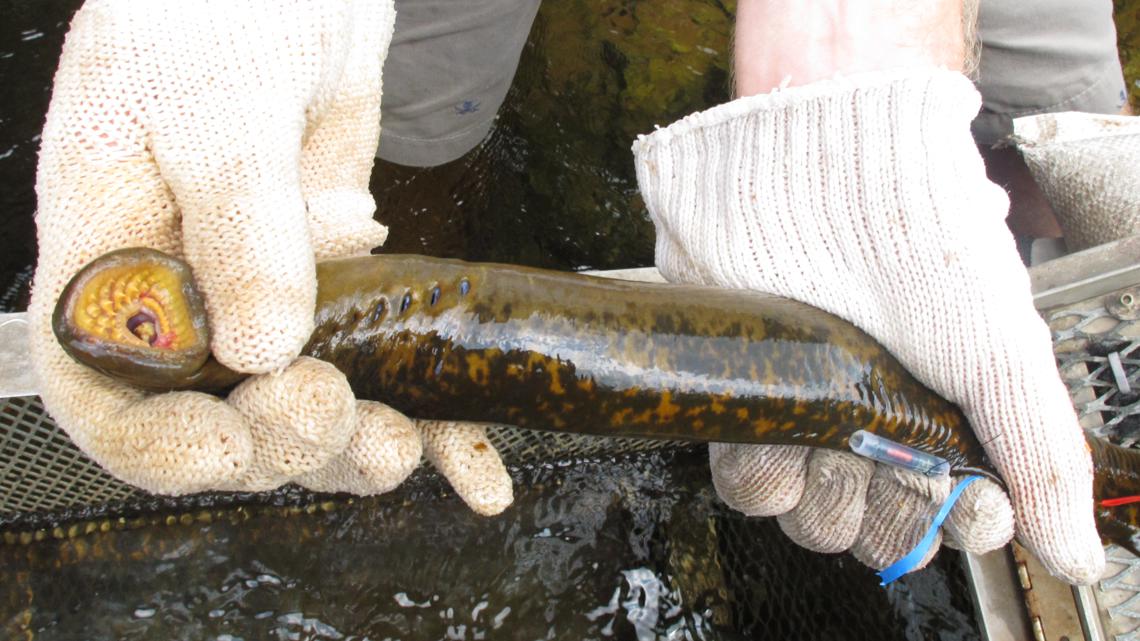ALEXANDRIA, Va. — The recent discovery of sea lamprey in the Potomac River has sparked significant debate. Some believe it is a native species that should be left alone, while others insist it is invasive and advocate for its removal.
So, WUSA9 looked into it.
First, it's important to note there are many types of lamprey. According to Dr. Eric Hilton, from the Virginia Institute of Marine Sciences, the sea lamprey is native to the Chesapeake region and migrates into fresh water every year to lay their eggs. However, they are seldom seen because they do not typically take fishermen's bait.
According to the U.S. Fish and Wildlife Service, sea lamprey is distinguished by its long, eel-like body that is typically 12-20 inches long. They are usually brown and yellow, with a lighter belly, and their bodies can be mottled with dark spots. Instead of a jaw, these creatures have round, sucker-like mouths filled with sharp teeth arranged in concentric circles. They also have seven pairs of gill openings located behind their eyes, and two dorsal fins, that are well separated.
Larvae do not have teeth or fully developed eyes, but do have the same seven circular gill openings as the adults.
It's not always easy to be able to tell the difference between the types of lamprey though.
Experts say the easiest way to do so, is by catching them and looking at their mouths (if you notice rows of pointed teeth, it's a sea lamprey) and by their size (sea lamprey can get up to 3-feet long).


Sea lamprey spawn in freshwater rivers, feeding on decaying plant and animal matter. After four to five years, they mature into blood-feeding adults and migrate to the ocean. In the ocean, they latch onto fish, using their suction-like mouths full of teeth to suck blood and tissue.
Though they have many predators and are not harmful to the ocean ecosystem, they can be damaging when they return to freshwater to lay eggs. However, their presence in the Chesapeake Bay is minimal and not considered a significant threat, unlike in the Great Lakes, where they have severely impacted fish populations.
In fact, if you spot a sea lamprey, it likely indicates that the river or stream is healthy. Experts note that lampreys are sensitive to pollutants and sediment, making them reliable indicators of water quality
A man, identified as a local fishing enthusiast and blogger, posted about catching a sea lamprey in the Potomac in Alexandria on his Instagram, sparking the conversation and catching more than a million views on TikTok. In the video, the 23-year-old exclaims excitedly that it's "the first sea lamprey caught in the Potomac river" but while it may be a first for him, it isn't for the area.
Here are some pros and cons of the species, according to wildlife experts:
Pros:
- Natural predator: They help control fish populations by praying on weak or sick fish.
- Nutrient cycling: Their activity helps contribute to the recycling of nutrients
- Evolutionary studies: They provide insights into the evolution of vertebrates due to their ancient orgins
- Biomedical research: They are studied for their unique immune systems and ability to regenerate spinal cord injuries.
- Indicator species: Serve as indicators of environmental changes and ecosystem health.
- Cultural significance: Used as a traditional food source in some cultures.
- Economic contribution: Harvested for food and other products in certain regions, supporting local economies.
Cons:
- Invasive species: In areas like the Great Lakes, sea lampreys are an invasive species that disrupt local ecosystems.
- Economic damage: They cause significant damage to commercial and recreational fisheries by preying on valuable fish species.
- Fish population declines: Their parasitic behavior can lead to severe declines in native fish populations, affecting biodiversity.
- Ecosystem imbalance: They can disrupt the balance of aquatic ecosystems, leading to consequences for other species.
- Control costs: Managing and controlling sea lamprey populations can be expensive, requiring ongoing efforts and resources.
- Impact on endangered species: They can pose a threat to already vulnerable or endangered fish species.
- Public perception: Their presence can negatively impact public perception of water bodies, potentially reducing tourism and recreational activities.
It's also important to note sea lamprey have been around for hundreds of millions of years, and most are threatened species.
A bite from a lamprey is not deadly, but it can be painful and lead to infection.
So if you see one in the Bay, leave it alone.
READ NEXT:
WATCH NEXT:
Do you have a news tip on this story or any other story? We want to hear from you. Tell us about it by emailing newstips@wusa9.com.
DOWNLOAD THE WUSA9 APP
Apple App Store: WUSA9 News on Apple
Google Play Store: WUSA9 News on Android
ROKU: add the channel from the ROKU store or by searching for WUSA9.
For both Apple TV and Fire TV, search for "WUSA9" to find the free app to add to your account. Another option for Fire TV is to have the app delivered directly to your Fire TV through Amazon.
Subscribe to our daily WUSA9 Newsletter for top stories from WUSA9 curated daily just for you. Get content and information right now for can’t-miss stories, Commanders content, weather, and more delivered right to your inbox.

